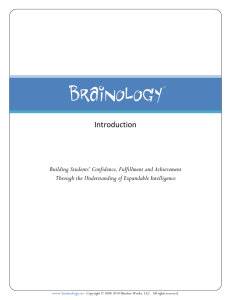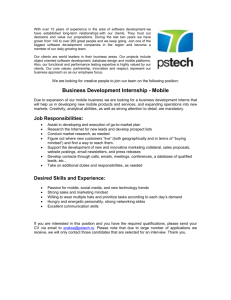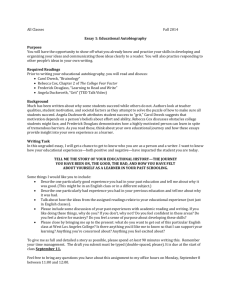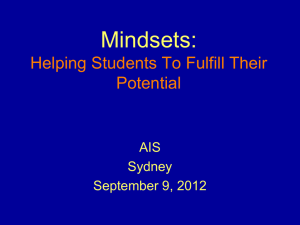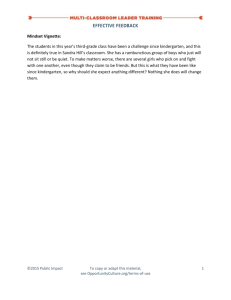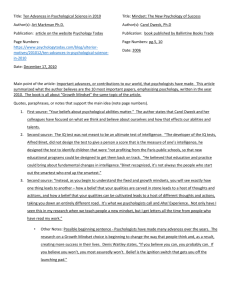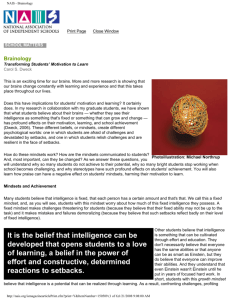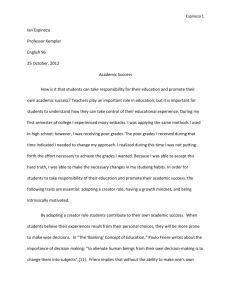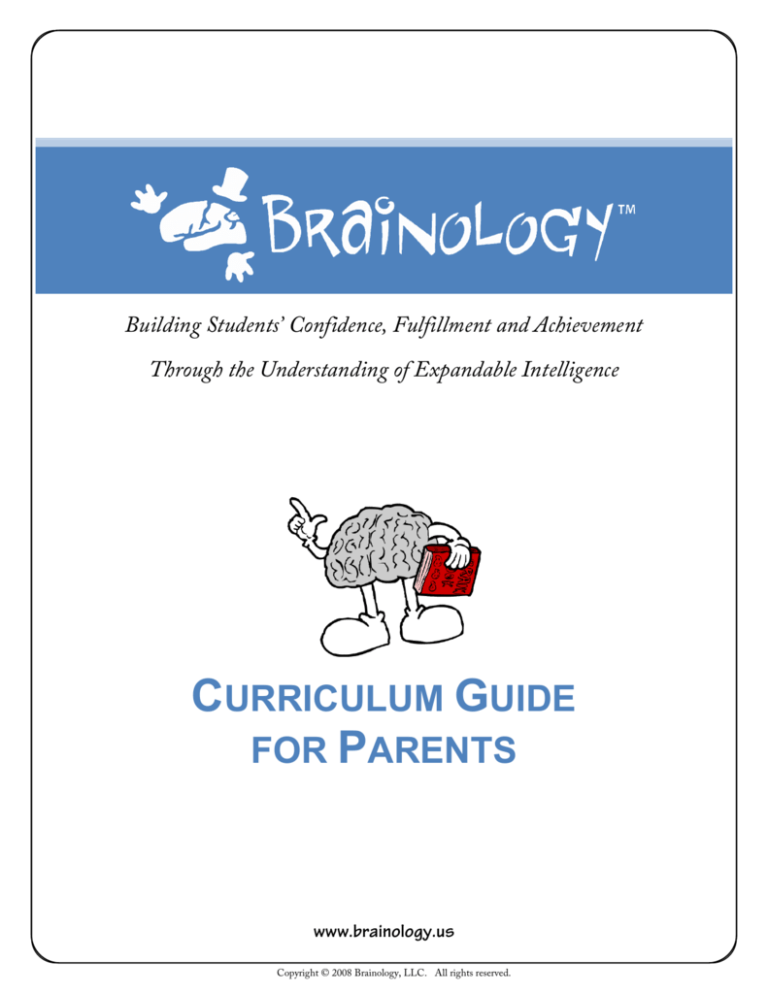
www.brainology.us
Building Students’ Confidence, Fulfillment and Achievement
Through the Understanding of Expandable Intelligence
CURRICULUM GUIDE
FOR PARENTS
www.brainology.us
Copyright © 2008 Brainology, LLC. All rights reserved.
What is this Curriculum Guide for Parents for?
This Curriculum Guide for Parents includes an introduction to the BrainologyTM
curriculum, an outline of the goals, lessons, common challenges and at-home
reinforcement strategies for each unit and an overview of the research behind
BrainologyTM. It is our belief that all of us can gain knowledge and forge positive
relationships over the course of this program that will yield benefits for years to come.
The Separate User Guide
You should also review the User Guide, which has instructions on how to enroll your
children in the program and it has a quick visual guide to using the program. You can
find the User Guide, along with other curricula that comes with BrainologyTM, in the My
Resources section of our website, specifically at
http://www.brainology.us/websitemedia/userguide.pdf.
Other Resources
Please do visit the My Resources section of our website. You will find there other
worksheets and key lesson summaries to use in between sessions and after completing the
BrainologyTM program. It is important to reinforce the BrainologyTM material in the
everyday life of the children so that they incorporate the lessons into their thinking and
behavior. Those materials in the My Resources section, as well as the content in this
Curriculum Guide for Parents, will help you to support your children’s growth mindset
development.
Customer Support & Feedback
If you have any questions or run into any issue please contact us anytime at
support@brainology.us. We also always welcome your questions, comments and ideas
on what we can do to better serve you at feedback@brainology.us.
We look forward to serving you and hope that BrainologyTM is very helpful to you and
your children.
Page 2
Copyright © 2008 Brainology, LLC. All rights reserved.
www.brainology.us
Overview
BRAINOLOGYTM CURRICULUM OVERVIEW
The goal of the Brainology curriculum is to help children develop a growth mindset.
TM
Children with a growth mindset think of their intelligence as something that they can
develop through learning and study rather than as something fixed. Cultivating a growth
mindset can help increase a child’s sense of self-efficacy and motivation to learn.
We help children develop a growth mindset by teaching them how the brain functions,
learns and remembers, and how it changes physically when we exercise it through study
and learning. In addition, we provide a practical set of skills for tackling academic
challenges by showing them how to apply this knowledge to their schoolwork.
Brainology is designed as a challenge-based, interactive multimedia instructional
TM
program. In an introduction plus four ~30 minute units, children follow animated
teenaged characters Chris and Dahlia as they tackle various problems in their most
difficult subjects. They visit the lab of eccentric brain scientist Dr. Cerebrus and learn
about the basic structure and function of the brain: how thinking occurs, how learning
and memory work, how to develop and change the brain, and how to improve their study
habits and skills in light of this knowledge. They gain experience in visualizing and
applying these ideas through interactive activities and exercises. Throughout the program
they reflect on their challenges and their learning through an E-Journal. The goal is for
them to understand that they have great, untapped potential and that the development of
BrainologyTM Curriculum Guide for Parents
their mental ability is largely within their own control, and to provide them with study
Page 3
habits and skills that will help them take action.
Through this Curriculum Guide for Parents we hope to help you support your children
by providing information and strategies that you can use to reinforce their growth
mindset development.
Copyright © 2008 Brainology, LLC. All rights reserved.
www.brainology.us
Overview
GUIDING YOUR CHILD
TO THE GROWTH MINDSET
It is important that the adults around the child are well versed on and embrace the
growth mindset. They need to be able to guide their children in their everyday life, and
model the behavior that the growth mindset advocates.
Of particular relevance to parents is the topic of praise, which we briefly discuss below. If
you would like a more in-depth discussion of this and other growth mindset topics, we
highly recommend our co-founder Carol Dweck’s book Mindset: The New Psychology of
Success. Additional resources are listed at the end of this section.
The Mindsets
Dr. Carol Dweck’s research shows that someone’s mindset profoundly affects the way
this person leads his or her life. It determines behavior which has significant
consequences.
• Fixed Mindset: The belief that one or more of your basic qualities are set in stone.
This mindset creates an urgency to prove yourself over and over by undertaking
efforts with low risk and high probability of success. Students with a fixed
mindset will frequently lose interest in a subject when it becomes difficult.
BrainologyTM Curriculum Guide for Parents
• Growth Mindset: The belief that your basic qualities can be cultivated through
Page 4
your own effort and that we don’t know the upper bounds of what anyone can
accomplish with years of passion, toil and training.
The Danger of Praise
No parent thinks “I wonder what I can do today to undermine my children, subvert their
effort, turn them off learning, and limit their achievement.” Of course not. They think “I
would do anything, give anything, to make my children successful.” Yet many of the
things they do boomerang. Their helpful judgments, their lessons, their motivating
techniques often send the wrong message.
Copyright © 2008 Brainology, LLC. All rights reserved.
www.brainology.us
Overview
In fact, every word and action sends a message. It tells children – or students or athletes –
how to think about themselves. It can be a fixed mindset message that says: “You have
permanent traits and I’m judging them.” Or it can be a growth mindset message that
says: “You are a developing person and I am interested in your development”...
Messages About Success
Listen for the messages in the following examples:
• “You learned that so quickly! You’re so smart!”
• “Look at that drawing. Martha, is he the next Picasso or what?”
• “You’re so brilliant, you got an A without even studying!”
If you’re like most parents, you hear these as supportive, esteem-boosting messages. But
listen more closely. See if you can hear other messages, the ones that children hear:
• “If I don’t learn something quickly, I’m not smart.”
• “I shouldn’t try drawing anything hard or they’ll see I’m no Picasso.”
• “I’d better quit studying or they won’t think I’m brilliant.”
Messages About Failure
Nine-year-old Elizabeth was on her way to her first gymnastics meet. Lanky, flexible,
and energetic, she was just right for gymnastics, and she loved it. Of course, she was a
BrainologyTM Curriculum Guide for Parents
little nervous about competing, but she was good at gymnastics and felt confident of
Page 5
doing well. She had even thought about the perfect place in her room to hang the ribbon
she would win.
In the first event, the floor exercises, Elizabeth went first. Although she did a nice job,
the scoring changed after the first few girls and she lost. Elizabeth also did well in the
other events, but not well enough to win. By the end of the evening, she had received no
ribbons and was devastated.
What would you do if you were Elizabeth’s parents?
1. Tell Elizabeth you thought she was the best.
Copyright © 2008 Brainology, LLC. All rights reserved.
www.brainology.us
Overview
2. Tell her she was robbed of a ribbon that was rightfully hers.
3. Reassure her that gymnastics is not that important
4. Tell her she has the ability and will surely win next time.
5. Tell her she didn’t deserve to win.
There is a strong message in our society about how to boost children’s self-esteem, and a
main part of that message is: protect them from failure! While this may help with the
immediate problem of a child’s disappointment, it can be harmful in the long run. Why?
Let’s look at the five possible reactions from a mindset point of view and listen to the
messages:
• The first (you thought she was the best) is basically insincere. She was not the best
– you know it, and she does too. This offers her no recipe for how to recover or
how to improve.
• The second (she was robbed) places blame on others, when in fact the problem
was mostly with her performance, not the judges. Do you want her to grow up
blaming others for her deficiencies?
• The third (reassure her that gymnastics doesn’t really matter) teaches her to
devalue something if she doesn’t do well in it right away. Is this really the message
you want to send?
BrainologyTM Curriculum Guide for Parents
• The fourth (she has the ability) may be the most dangerous message of all. Does
Page 6
ability automatically take you where you want to go? If Elizabeth didn’t win this
meet, why should she win the next one?
• The last option (tell her she didn’t deserve to win) seems hardhearted under the
circumstances. And of course you wouldn’t say it quite that way. But that’s pretty
much what her growth-minded father told her.
Copyright © 2008 Brainology, LLC. All rights reserved.
www.brainology.us
Overview
Healthy Praise
After seven experiments with hundreds of children, we have clear findings that praising
children’s intelligence lessens their motivation and harms their performance. Instead of
praising talent and intelligence, focus on your child’s effort and behavior. For example:
rather than saying, “You are very smart for getting an A in math”, you can say “You must
have tried very hard to get an A in math”. This puts the praise on the effort and the
behavior rather than on the outcome, the A in math. Upon failure, you could say “I know
how you feel. It’s disappointing to have your hopes up and to perform your best but not
make the squad, but it happens to everybody and we must take it as a learning experience.
If this is something that you really want, then it’s something you’ll really have to work
for, as with everything else in life. We can try different approaches and learn from them
to find the way to success.” This approach allows you to console and empathize with your
child. It also gives your child the opportunity to grow from her failure and teaches her
that through hard work and effort she can undertake lifelong learning and selfimprovement.
Additional Resources
For additional resources on these topics you may want to read:
• Dr. Carol Dweck’s book Mindset: The New Psychology of Success, which
includes a chapter on Parents, Teachers and Coaches. The book’s website is
BrainologyTM Curriculum Guide for Parents
http://www.mindsetonline.com/
Page 7
• A summary of the research that led to BrainologyTM:
http://www.brainology.us/websitemedia/info/brainology_intro_pres.pdf
• How Not to Talk to Your Kids: The inverse power of praise, New York Magazine
cover article, Feb. 17 2007: http://nymag.com/news/features/27840/
• The Secret to Raising Smart Kids, Scientific American, Dec. 2007:
http://www.sciam.com/article.cfm?id=the-secret-to-raising-smart-kids
Copyright © 2008 Brainology, LLC. All rights reserved.
www.brainology.us
U ni t 1 : Brain B asi cs
UNIT 1: BRAIN BASICS
Unit Goal
Children learn the basics of brain structure and function,
particularly what is required to maintain readiness to learn and
how attention and concentration are supported. This unit
prepares children both for higher-level understanding of thinking
and learning processes that underlie a growth mindset, and for
more advanced study strategies.
Key Challenge Children have difficulty concentrating on school work.
Main Information from Unit 1
•
The brain needs certain things in order to function well. Some examples are sleep, and
foods like eggs, nuts and fish that contain important chemicals.
•
The brain is the body’s control center: it gets information from all your senses, and is in
charge of all of the body’s voluntary and involuntary movement.
•
Different areas of the brain take in information from different senses and do different
things.
•
Your senses serve as different “pathways” to the brain: using more than one sense to
learn about something lets you use more of your brain and aids learning and memory.
•
Using different complementary modes of learning one thing can help focus your attention
BrainologyTM Curriculum Guide for Parents
and increase learning. For example, seeing a picture while hearing an explanation is a
Page 8
very effective way to learn.
•
In contrast, getting information about different competing things through different
senses can interfere with learning. For example, playing a CD and watching a cartoon
while trying to read may distract you and reduce your learning capacity.
•
In other words, we can ask ourselves: are my different senses pulling me in the same
direction, or in all different directions?
•
Active learning approaches are best, because they help to keep your attention focused on
the subject, and increase understanding of the subject.
Copyright © 2008 Brainology, LLC. All rights reserved.
www.brainology.us
U ni t 1 : Brain B asi cs
What promotes self-efficacy?
Self-efficacy is the feeling that you have the power to achieve or do something through
your own efforts. Young people usually do not feel in control—of their environment, of
the things they must learn, of the standards they must meet, of their success or
achievement level. By helping children understand how to use their brains in a more
effective way, you can help your child to feel more in control of themselves and of what
they can achieve.
Discussion Activities
These discussion activities are ideas to get you started, and ways to reinforce the concepts
that your child is learning. Discussions should take place after each interactive lesson, or
during other time throughout the week. Or, you may ask your child to write about these
questions and then share their responses.
All of Your Brain!
Why do you think it is easier to learn things you are interested in than things you
find boring? What do you do differently when you are learning about something
you like?
Possible responses include:
• I pay attention!
• I take an active approach, practicing and getting involved.
BrainologyTM Curriculum Guide for Parents
• I keep working at it even when it is hard.
Page 9
• I think about it even when you are not doing it.
• I share it with others.
• I stay focused on the task.
• I use my whole brain!
How could you use these strategies in your studies? How could you use more
senses, and more of your brain, in your coursework? Possible responses include:
• I could discuss the information with others.
• I could draw myself a diagram.
• I could repeat aloud the information to myself.
Copyright © 2008 Brainology, LLC. All rights reserved.
www.brainology.us
U ni t 1 : Brain B asi cs
Reinforcement Strategies
Child Feedback:
Use opportunities at home to praise your child for using all the different parts of their
brains through varied learning strategies. Some examples include:
• Drawing a diagram to help you see your work is a great problem-solving strategy!
• Good job explaining the problem aloud; it really helps to talk things out!
Concrete Strategies:
The use of different learning strategies can also be facilitated while learning different
subjects. Some examples include:
• After reading part of a math text book, or a math problem, ask your child to
rephrase the main ideas of the text, or explain the main points of the problem to
you.
• Children can design their own cartoon strips to rephrase key parts of a lesson, retell a story problem or sequence problem-solving steps.
• Children can use other senses and abilities when they work in small groups to
cooperatively solve problems.
Give Yourself a Brain Scan:
Remind your child that they need to think about whether they have given their brains
everything they need to learn well. Suggest that they be their own brain scientist and use
BrainologyTM Curriculum Guide for Parents
a checklist to make sure they are giving their brains all the help they need:
• Have you eaten a good breakfast/lunch today?
• Did you get enough sleep last night?
• Did you keep your attention on this when you were trying to learn it?
• Were there other distractions in your environment when you were trying to learn?
• Did you use more than one sense to learn this material?
• Did you find an active way to practice this material?
By helping your child understand how their brain works and how they can help it to work
better, you are laying the groundwork for them to develop a sense of self-mastery and a
growth mindset!
P a g e 10
Copyright © 2008 Brainology, LLC. All rights reserved.
www.brainology.us
U ni t 2 : B r a i n B e h a v i o r
UNIT 2: BRAIN BEHAVIOR
Unit Goal
Children learn that the brain functions by sending chemical
messages through a network of nerve cells, and that these cells are
responsible for thought. This insight provides a foundation for
understanding how learning changes the brain—the growth
mindset. They also learn how emotions can influence the brain
and are taught strategies for managing their negative emotions
and enhancing the positive ones.
Key Challenge Children whose learning and performance are hampered by test
anxiety and other negative emotions need to learn to manage their
anxiety with a little knowledge about how the brain works.
Main Information from Unit 2
•
The brain is made up of nerve cells, called neurons, in a network of over 1 trillion
connections.
•
Neurons communicate with each other through these connections, using chemicals called
neurotransmitters.
•
The branching parts, called dendrites, receive messages, and the long part, called the axon,
BrainologyTM Curriculum Guide for Parents
transmits a signal through the neuron.
P a g e 11
•
Thinking is influenced by the emotions, especially anxiety.
•
When facing any type of threat, the brain sets off a fight-or-flight response that causes
physical signs of anxiety, which interfere with thinking.
•
Many students have performance anxiety—stress related to taking tests, giving
presentations, or other performance-oriented situations—that can interfere with
performance even when they know the material.
•
You can lower your anxiety level by being prepared, thinking positively, and calming your
breathing.
Copyright © 2008 Brainology, LLC. All rights reserved.
www.brainology.us
U ni t 2 : B r a i n B e h a v i o r
What makes children want to learn?
When children are focused on learning as a goal, they are more likely to stick with
difficult things, to seek help when they need it, and to work hard even when they don’t
have to. But, because many children are worried about performing poorly in the very
areas where they most need to learn, they may be too afraid of “looking dumb” to risk
trying to learn. Anxiety is often a product of a fixed mindset, in which every performance
is high-stakes. We can help to focus children on a learning goal by letting them know
that learning usually involves making mistakes, showing one’s lack of skill and not doing
as well as others who are more expert. Children often feel that only top performers are
successful and admired by others. Focusing on a child’s growth and progress, rather than
on their performance relative to others, can decrease their fear of “looking dumb.”
Remind your child that everyone blunders when they are learning something. Let your
child know that mistakes are not only okay, they can be useful feedback in the learning
process. Praise your child for their effort and progress, and don’t overemphasize perfect
performance.
Discussion Activities
Meeting the Challenge
Michael Jordan did not make his high school basketball team. Helen Keller was
mistaken for mentally disabled early in life. Albert Einstein failed classes in
grammar school. Yet they all went on to achieve great things in their fields of
BrainologyTM Curriculum Guide for Parents
expertise and in their lives.
P a g e 12
• What do you think they did to overcome these challenges and achieve their
goals?
• Is there a high-pressure situation in your students’ lives where they
overcame a challenge? In this situation, what did they do to achieve their
goals?
• Consider the strategies that Dr. C. shares with Chris and Dahlia. Have
your child discuss how these strategies have worked for them in the past or
could work for them in the future.
Copyright © 2008 Brainology, LLC. All rights reserved.
www.brainology.us
U ni t 2 : B r a i n B e h a v i o r
• Often people are judged based not on their ability to learn but rather on
unusual beliefs they hold or because of a prejudice, such as “Girls can’t do
math.” Women such as Mae Jemison, the first African American woman
in space, faced such prejudice. And Jill Cornell Tarter, the first woman to
head SETI, a group that uses technology and science to search for life on
other planets, struggled because of her unusual beliefs. How do you suppose
these women used Dr. C’s strategies to stay focused and meet their goals?
Reinforcement Strategies
Child Feedback:
Encourage your child to use new strategies and not be discouraged by difficulties they are
having by praising their process. Making mistakes is an important part of learning.
Reminding your child that math is tough, especially when it is a brand new skill will help
them stay persistent. Knowing that other people struggle, too, helps children overcome
their frustration with difficult new applications.
For example,
• If you could already do it perfectly, you wouldn’t be learning anything.
• I don’t know anyone who hasn’t struggled with this kind of word problem, until
they learn how to do it.
• Your skills have really improved in this subject!
• You can use this mistake. Think about why it didn’t work, and learn from it.
BrainologyTM Curriculum Guide for Parents
• Don’t worry about getting it wrong—I just want you to understand how to do it.
P a g e 13
• You know, if you learn how to do this type of problem it will really help you with
________ (e.g. mention some way that a math skill might be applicable in your
child’s life, for example keeping track of sports scores, comparing two items to see
which is a better value for purchase, etc.)
Copyright © 2008 Brainology, LLC. All rights reserved.
www.brainology.us
U ni t 2 : B r a i n B e h a v i o r
Give Yourself a Brain Scan!
Children often have performance anxiety, particularly when it comes to test-taking,
giving presentations, or discussing their questions and problems with the class. This
anxiety can interfere with learning and performance much more often than we may
recognize. To deal with anxiety about performance, address stress directly to show that it
is perfectly normal to feel anxious when being tested or performing new skills. Suggest
that your child tries the following strategies to manage anxiety:
• Change thoughts and preconceptions about test taking from negative to positive—
instead of saying, “I’m going to fail,” say, “I’m going to do my best.” Set positive
and realistic goals.
• Focus on the PROCESS, not the OUTCOME. A learning or test-taking strategy
(process) that includes studying as well as ways to relax before and during a test, if
your child begins to panic, will ultimately yield a better test score (outcome)
without placing emphasis on the score alone.
• Square breathing can really help your child if they start to panic during a test, or
any other time they feel overcome with anxiety. Use a moment of square breathing
to relax your mind during a test—taking time out can help you finish what you
BrainologyTM Curriculum Guide for Parents
need to do and feel good about it, too.
P a g e 14
Copyright © 2008 Brainology, LLC. All rights reserved.
www.brainology.us
U ni t 3 : B r a in B u il di ng
UNIT 3: BRAIN BUILDING
Unit Goal
Children discover how learning changes the brain, through the
growth of connections in neural networks with repeated use, the
key to the growth mindset. Children learn that intelligence can
be developed through mental exercise, and what sorts of activities
promote learning.
Key Challenge Children have difficulty learning, especially in certain subjects,
because they don’t put in enough effort.
Main Information from Unit 3
•
The brain and intelligence are not fixed—they both change when you learn.
•
The brain grows more new cells and the cells make new connections when you learn.
•
You get smarter by exercising your brain, much the same way that you get stronger by
exercising your muscles.
•
How can you exercise the brain?
o You exercise the brain by exploring new information, learning new concepts, and
practicing skills.
o Practice is the key to learning—only by practicing something over and over again
BrainologyTM Curriculum Guide for Parents
can you grow new connections in that area of your brain responsible for learning
P a g e 15
that thing.
o The more connections you make, the easier it gets to make new ones.
•
Learning actually causes the brain to grow more dense (as shown in studies with lab rats)
and areas of the brain to grow larger and more active (in studies with people).
•
Different environments can influence brain growth--active learning is the key.
•
You are never too old to learn and develop your brain!
Copyright © 2008 Brainology, LLC. All rights reserved.
www.brainology.us
U ni t 3 : B r a in B u il di ng
Additional Information for Parents
This is the model of strengthening the brain and building intelligence that is
introduced in this unit:
New
Concept or
Skill is
introduced
Unintelligence
Practice
The branches
Children
Neurons in
of new
of the neurons
read the
the part of the
concept
start to grow
new
brain
or skill
and make new
concept, or
responsible for
over and
connections
do the skill
that skill are
over
with lots of
once
stimulated
again
other neurons
(Learning is Occurring; Student is Becoming Smarter)
The brain
becomes
denser
Intelligence
Discussion Activities
These discussion activities are ideas to get you started, and ways to reinforce the concepts
that your child is are learning. Discussions can take place after each interactive lesson, or
during other time throughout the week.
Remember when we learned about?
It seems “easy” to learn some of our favorite things to do: playing games,
remembering basketball stats, playing video games, writing songs etc. The things
BrainologyTM Curriculum Guide for Parents
that seem “easy” to us actually are complex tasks that require lots of work and
P a g e 16
effort. Have your child discuss:
• What is your favorite thing to do? (Don’t limit yourself to school subjects:
think of any activity that you love)
• Recall when you first did this activity. How did you learn how to do it?
• Do you think you’re better at this activity now? If so, how did you get to
that point; how were you able to get better?
• Did you have to mess up lots of times before you got it right? Do you think
you were learning from your mistakes too?
Copyright © 2008 Brainology, LLC. All rights reserved.
www.brainology.us
U ni t 3 : B r a in B u il di ng
What holds children back?
• Do you ever hear other kids call each other “stupid” or “dummy”?
• How does that make people feel? Does it make them try harder, or give up?
• What happens when you give up, or don’t put in effort on something?
• So what are messages like that doing to us?
• Based on what you have learned in this unit, does that make sense? Why not?
Sometimes people put those kinds of labels on themselves, or get so worried that
someone else might put a negative label on them, that they are afraid to try to
learn something new, or to practice something they’re not good at yet. This is
called self-handicapping. It means you set yourself up to fail. What is a better
strategy to succeed? (Hint: think about what you did to succeed at your “favorite
thing.”)
What makes children work hard?
Let’s face it, working hard can be—hard! What makes it worthwhile is the belief that
you can gain something by doing it. As long as children don’t receive a paycheck ,
learning and developing their ability is their main payoff for hard work! Research shows
that children who believe that effort will make them more successful work more
persistently and do better in school than students who think that success is something
that should come easily. And when children have a growth mindset and see their ability
as something they can develop, they are more likely to be willing to work hard and want
to learn. As a parent, you can reinforce the importance of effort by giving feedback that
BrainologyTM Curriculum Guide for Parents
lets your child know how valuable it is and by reminding your child that when he/she
works hard he/she is “working out” his/her brain.
Reinforcement Strategies
Child feedback:
P a g e 17
• If it were easy, you wouldn’t be learning anything.
• When it’s hard work, that’s how you know you’re building your brain!
• Every time you practice, you’re making the connection in your brain stronger.
• Everything is hard before it gets easy.
• You’re good at things you like because you work at them.
Copyright © 2008 Brainology, LLC. All rights reserved.
www.brainology.us
U ni t 3 : B r a in B u il di ng
• You just need to put in more time and thought and you’ll get this.
• If you work half as hard at this as you do at (video games, basketball, etc.) you’ll be
doing great!
Concrete Strategies:
• Do reps or sets of types of problems: Just like when you exercise in the gym, you
can build up your “brain muscles” by practicing solving sets of problems that use
the same mental skills, or neuron connections. The more you practice similar
problems together, the stronger those skills will become.
• Isolate key skills and practice these: If you are learning a complicated physical
skill, you practice small parts of the skill by themselves to make your whole
performance stronger. For example, in learning to dance, or to play ball, you
practice one move over and over to get it down. You can do the same in your
schoolwork by picking one skill that you find difficult by practicing it many times.
Give Yourself a Brain Scan:
In order to learn and get smarter at something, you need to build up your brain by
working it out—by practicing and learning challenging new things. The next time you
have something difficult to learn, use the following strategies to keep yourself motivated
and give it your best effort:
• Do I feel worried about how well I’m going to do this? (Use strategies from Unit
2 to manage anxiety)
BrainologyTM Curriculum Guide for Parents
• Have I been holding back my effort—self-handicapping—on this in the past?
P a g e 18
• Do I want to choose to get smarter and better at this?
• Am I willing to put in the effort it takes?
• How much time do I need for this, and am I giving myself enough time?
• Picture the nerve cells in your brain growing when you practice.
• If you get discouraged, think about how much smarter you are now than a year
ago.
• Remember how much practice you put in on the things you like, and try to put in
half that much!
Copyright © 2008 Brainology, LLC. All rights reserved.
www.brainology.us
U ni t 4 : B r a in B o os t e rs
UNIT 4: BRAIN BOOSTERS
Unit Goal
Extend the concept of the malleable brain to understanding the
processes of memory. Introduce a variety of study strategies to
capitalize on the way the brain works and learns, to deepen and
reinforce your child’s understanding of the growth mindset, and
guide your child to the study skills resources within the program.
Key Challenge Children give up when they encounter initial difficulty because
they lack a variety of good learning strategies.
Main Information from Unit 4
• Memory is stored in the new connections your brain makes between neurons when
you have a new experience.
• There are different stages in memory, each lasting different a amount of time:
sensory memory, working memory, and long-term memory.
• Memory is a process, and if you skip one stage, the memory will not last.
• All information enters through sensory memory, which lasts less than a second.
• Things you pay attention to go on to working memory, which lasts from seconds to
minutes. This memory can only hold 5-7 separate pieces of information at once.
• Information moves from working memory to long-term memory through a process
called encoding. In order for encoding to happen, you must pay attention, attach
BrainologyTM Curriculum Guide for Parents
new information to existing information that supports it and repeat the
P a g e 19
information.
• An example of connecting information together to help expand memory is
chunking, where you remember several bits of information together in a pattern.
Other mnemonics (memory strategies) that connect information together in
multiple ways include visual images and acronyms.
•
Most good study strategies are those that reinforce this memory process, helping
your brain to make many strong connections between neurons and build a strong
communication network of knowledge.
Copyright © 2008 Brainology, LLC. All rights reserved.
www.brainology.us
U ni t 4 : B r a in B o os t e rs
Some examples of good study strategies can be remembered through the acronym
BRAIN:
•
Break down information into basic elements
•
Repeat, review, practice skills and information to strengthen memory
•
Actively practice new information
•
Information-seeking through expert sources
•
Never give up—stay with the task long enough to let learning and memory take hold!
Discussion Activities
To study effectively you need to “study smart”--find the right strategy and use time well.
Below are two ways of studying. Each takes 45 minutes. Which way will work better?
1) Sit and stare at your math book, but don’t open it up. Stare at it REALLY HARD
for 12 minutes. Then open it up and read one problem. Get frustrated when you don’t
understand it in 3 minutes, and close the book. Turn on the TV for 10 minutes. Spend
20 minutes looking for your math homework sheet. Give up when you can’t find it.
2) Write down math rules and problems on index cards. (15 minutes) Read them a few
times (15 minutes) Then find a friend to quiz you on the problems (5 minutes) Pick the
ones you had trouble with and read them over again (10 minutes).
BrainologyTM Curriculum Guide for Parents
• Which one sounds the most like your own study time?
• Does this method work for you?
• Remember the acronym BRAIN. Can you see any ways that study method (1)
used these strategies? How about study method (2)?
What are the most important study skills?
By encouraging your child to focus on effort, strategy, and incremental learning, you are
laying the foundations for a constructive approach to learning and supporting a growth
mindset. To help them turn that positive motivation into practical achievement gains,
remind them of the importance of using the right strategies. Many children fail to
understand their role in controlling their own learning. There are a few key skills and
P a g e 20
Copyright © 2008 Brainology, LLC. All rights reserved.
www.brainology.us
U ni t 4 : B r a in B o os t e rs
principles that underlie the majority of study strategies, yet are unknown to many
children. Focusing one’s attention, taking an active role in learning, repetition, and
monitoring one’s own knowledge, are among these strategies.
Reinforcement Strategies
Strategy-Supporting Feedback
By encouraging your child to emphasize their learning strategies, you will help them
remember that they can control how much they learn. When we associate the things we
want to remember with the things we already know and find to be important, the move
from working to long-term memory can be more easily made! Suggestions for feedback
include:
• Remember, nothing gets in unless you shine your “attention spotlight” on it!
• Take charge of this, get active!
• Think about what you need to do: what strategies can you use?
• Question yourself: What do I already know about this subject? What do I need to
know? Am I using the right strategy?
• If you don’t understand something, ask!
• See if you can explain it to someone else. That’s the best way to learn.
Concrete Strategies
Like a network of neurons, a math class is a series of ideas connected together to make
BrainologyTM Curriculum Guide for Parents
solving math problems possible. The following ideas might help remind your child that
just like their brains, math is a complex connection of messages:
P a g e 21
• PEMDAS (please excuse my dear aunt sally) is a mnemonic that helps you remember
the order of mathematical operations you must follow in solving a problem. Have
your child create their own mnemonic devices and post them around the house or
in their bedroom for inspiration.
• Learning the most basic way to solve a problem leads us to figure out how to
manage similar problems with more complexity and more steps. Have your child
map out math problems, showing the series of steps and the basic operations
needed to solve the problem.
Copyright © 2008 Brainology, LLC. All rights reserved.
www.brainology.us
U ni t 4 : B r a in B o os t e rs
• Write a problem on a sheet of paper that is solved in several lines. Cut the paper
into strips so that each step is on a separate strip. Have your child put the pieces
together in the correct order.
• Consider things children have strong emotional attachments to and make school
connect with those topics, for example keeping a diagram of the Final Four or
tracking the rate at which a tropical storm is approaching the city.
• Making connections with things your child is interested in will help them
remember concepts. Link a new concept in math with a favorite song.
Give Yourself a Brain Scan
To learn well, you shouldn’t stop with working hard—you need to work smart too! Use
the mnemonic BRAIN to check whether you have brought your toolkit of strategies.
Did you:
• Break down information into basic elements
• Repeat, review, practice skills and information to strengthen memory
• Actively practice new information
• Information-seeking through expert sources
• Never give up—stay with the task long enough to let learning and memory take
BrainologyTM Curriculum Guide for Parents
hold!
P a g e 22
Copyright © 2008 Brainology, LLC. All rights reserved.
www.brainology.us
Research Background Overview
RESEARCH BACKGROUND OVERVIEW
During adolescence, students are at risk for underachievement, particularly in the area of
mathematics and sciences. Over the past two decades, the main goal of two of our cofounders, Carol S. Dweck, Ph.D., and Lisa Sorich Blackwell, Ph.D., has been to research
what helps students to achieve highly, and to apply the lessons learned to improving their
motivation and achievement.
Achievement Motivation
In Drs. Dweck and Blackwell’s research, we have found that the beliefs and attitudes held
by students when they begin junior high school have a strong influence on their
achievement in mathematics over these critical years.
In particular, the research found that students who believed that their intelligence was
something that they could develop and increase—what we term a growth mindset—also
held many other positive attitudes. First, believing that their ability could be increased,
they valued learning as a goal, even when it involved hard work or initial errors. They
also believed in the efficacy of effort—that is, they viewed effort in a positive way and felt
that they had the ability, through their own efforts, to learn and master new material up
to standard. When they had difficulty in a subject, they made more constructive,
mastery-oriented explanations—rather than just saying, “I’m not smart enough,” or “I
just can’t do math,” they explained their difficulty as due to lack of effort or inadequate
BrainologyTM Curriculum Guide for Parents
strategy. And responded with more positive, effort-based strategies to work harder and
spend more time on the subject instead of giving up.
Even more striking, students with a growth mindset had an upward trajectory in
mathematics grades over seventh and eighth grade, while those who viewed their
intelligence as a fixed quality did not. This was true even though students had equal
levels of prior achievement: students who believed that their intelligence was malleable
did better than did equally able students who viewed their intelligence as an
unchangeable, fixed “entity.” This was true for students at all levels of ability (see Figure
1).
P a g e 23
Copyright © 2008 Brainology, LLC. All rights reserved.
www.brainology.us
Research Background Overview
Our research, as well as that of others, has shown that students who hold a growth
mindset use more sophisticated strategies in their coursework. For example, they use
more complex cognitive and meta-cognitive strategies–those that involve active and
deeper-level processing of material, and self-monitoring of the learning process.
Positive,
Learning
Effort-based
Goals
Strategies
Increasing Math Scores
Growth
Mindset
Across Junior High
School
Belief in
Efficacy
of Effort
How beliefs and goals promote higher mathematics achievement as shown in prior research.
BrainologyTM Curriculum Guide for Parents
Figure 1.
Masteryoriented,
effort-based
explanation
P a g e 24
Copyright © 2008 Brainology, LLC. All rights reserved.
www.brainology.us
Research Background Overview
Research on Learning and the Brain
In the same period of time, research has shown that the brain is in fact much more
malleable than previously thought. It was once believed that the brain did not grow new
cells, and that there were severe limitations on the malleability, or neuroplasticity, of the
brain after early childhood. But in the past few decades, research has shown that learning
causes substantial changes in the brains of both animals and human beings throughout
life.
Thinking occurs in the brain through the chemical communication of nerve cells
connected in a complex network. With learning, the cells of the brain develop new
connections between them, and existing connections become stronger. Studies in
neurophysiology, neuroanatomy, and brain imaging have shown that when people
practice and learn new skills, the areas of the brain responsible for those skills actually
become larger and denser with neural tissue, and that new areas of the brain become
active when performing related tasks. Furthermore, it has been found that the brain
continues to grow new nerve cells, or neurons, daily, and that this process speeds up when
a lot of active learning is occurring.
Thus, the brain has the capacity to develop throughout life. However, this development
depends on the stimulation of challenge and learning. This fact makes it all the more
critical that students be given challenging material and motivated to apply effort and take
BrainologyTM Curriculum Guide for Parents
an active role in learning.
Intervention Approach: Teaching a Growth Mindset
Would it be possible to improve students’ motivation and achievement by teaching them
a growth mindset? In a pilot study, we did just that by teaching middle school students
about what has been learned about the flexibility of the brain to develop and grow new
networks with challenge and learning. We then examined changes in their motivation
and mathematics achievement over the year of the intervention, comparing them with a
similar group of students in the same school who did not receive this intervention.
P a g e 25
Copyright © 2008 Brainology, LLC. All rights reserved.
www.brainology.us
Research Background Overview
Pilot Study Results
Gains in motivation: We asked teachers to assess changes in their students’ classroom
motivation over the period of the intervention. Note that in the pilot study we taught the
growth mindset intervention to students outside of their class periods, and teachers did
not participate in the intervention. Thus, teachers were unfamiliar with the content of
the intervention, and they did not know which of their students had received instruction
in the malleable brain. Yet teachers cited significantly more of the students who had
received the growth mindset training as showing positive change in their effort and
interest in (see Figure 2).
Percent Identified as Increasing in Motivation
30%
*
25%
27%
20%
15%
10%
9%
5%
0%
BrainologyTM Curriculum Guide for Parents
* p < .05
Control
Experimental
Figure 2. Teacher-rated change in students’ classroom motivation (effort, interest in
learning) following intervention. (Note: Experimental group was taught lesson on
malleable intelligence.)
P a g e 26
Copyright © 2008 Brainology, LLC. All rights reserved.
www.brainology.us
Research Background Overview
Following are some comments from teachers about these students:
“M. was performing far below grade level. During the past few weeks, she has
voluntarily asked for extra help from me during her lunch period in order to improve her testtaking performance. Her grades drastically improved from failing to an 84 on the most-recent
exam.”
“Lately I have noticed that students have a greater appreciation for improvement in
academic performance. R. was performing below standards, but now he has learned to
appreciate the improvement from his grades of 52, 46, and 49 to his grades of 67 and 71. He
valued his growth in learning Mathematics.”
“Your workshop has already had an effect. L., who never puts in any extra effort and
often doesn’t turn in homework on time, actually stayed up late working for hours to finish an
assignment early so I could review it and give him a chance to revise it. He earned a B+ on the
assignment (he had been getting C’s and lower).”
“Several students have voluntarily participated in peer tutoring sessions during their
lunch periods or after school. These students were passing when they requested the extra help and
motivated by the prospect of sheer improvement.”
Gains in Math Achievement: The mathematics grades of all students in the study had
been declining prior to the intervention. However, after the intervention, the grades of
BrainologyTM Curriculum Guide for Parents
those students who learned about the growth mindset (experimental group) took an
upward turn, while those of their fellow students who did not receive this curriculum
continued to decline (see Figure 3.)
P a g e 27
Copyright © 2008 Brainology, LLC. All rights reserved.
www.brainology.us
Research Background Overview
3.00
2.90
2.80
2.70
Experimental
2.60
2.50
2.40
Control
2.30
2.20
2.10
2.00
Time 1
Time 2
(Pre-Intervention)
Time 3
(Post-Intervention)
Figure 3. Math grade curves over period of the intervention (T1=spring 6th, T2=fall 7th,
T3=spring 7th)
References
Blackwell, L., Trzesniewski, K., & Dweck, C. (2007). Implicit Theories of Intelligence
Predict
Achievement Across an Adolescent Transition: A Longitudinal Study and
an Intervention.
Child Development, Vol. 78, No. 1, pp. 246-263.
BrainologyTM Curriculum Guide for Parents
Dweck, C. (2006). Mindset: The New Psychology of Success. Random House: New York.
Acknowledgements
The quoted research was funded by grants from the William T. Grant Foundation and
the Spencer Foundation.
P a g e 28
Copyright © 2008 Brainology, LLC. All rights reserved.
www.brainology.us
C u s tom e r S u p po r t & F ee d b a c k
Customer Support & Feedback
If you have any questions or run into any issue please contact us anytime at
support@brainology.us.
We also always welcome your questions, comments and ideas on what we can do to
better serve you. Please send them to us at feedback@brainology.us.
We look forward to serving you and hope that BrainologyTM is very helpful to you and
your students.
BrainologyTM Curriculum Guide for Parents
www.brainology.us
P a g e 29
Copyright © 2008 Brainology, LLC. All rights reserved.
www.brainology.us

